HUAWEI 智能呼叫中心 话单指南(V300R005C15_01)
- 格式:pdf
- 大小:738.99 KB
- 文档页数:63

1目的本文描述了目前北京智能网华为、西门子SCP8通话话单、短信话单、充值话单的详细解析流程,用于核对北京智能网话单采集程序中可能存在的问题。
2适用范围适用于北京智能网话单解析的开发和维护人员。
3术语简写说明:一般的,话单记录以"|"进行分割,话单中的透明字段以";"进行分割。
#1,#2,#3……#n,表示对原始话单以"|"分割后,第1,第2,第3……第n个字段;$1,$2,$3……$n,表示原始话单中透明字段以";"分割后,第1,第2,第3……第n个字段T1,T2,T3……Tn,表示解析后话单的第1,第2,第3……第n个字段;4参考资料无。
5规则和流程描述5.1西门子通话话单5.1.1原始文件说明西门子PPS7U V75平台,设备包括SCP7,SCP8,SCP9。
原单话单文件格式:Microsoft OfficeExcel 工作表MOC格式举例:8|1|303|211|0x7070C03B|10|555|86|FFFFFFFFFFFFFFFF|86|-1|0|96531|0|-1|8|33|1|545|0|0|96531|0 |-1|?|25|1817|?|?|0|10137|0|46|8613000109;000000555;000060;;;0;0000;;;;25;0;0MTC格式举例:8|1|314|217|0x7070C03B|11|555|86|FFFFFFFFFFFFFFFF|86|-1|0|86|0|-1|250|25|1|579|0|0|86|0|-1| ?|20|6546|?|?|0|10142|0|57|100555;0086;8613000191;22000;;0;0000;;;;20;0;05.1.2字段规则中间数据,这些数据为计算最终结果所用解析后话单格式(如没有特别指明,则MOC/MTC取值方法相同):5.1.3解析流程5.1.4Call_Type流程5.1.4.1C allType定义原始话单的CallType定义:CALLING_UNICOM_MOBILE_DEFAULT = 0;CALLING_UNICOM_MOBILE_LOCAL_CALL = 1;CALLING_UNICOM_MOBILE_REGIONAL_CALL = 2;CALLING_UNICOM_MOBILE_PROVINCE_CALL = 3;CALLING_UNICOM_MOBILE_LONG_DISTANCE_CALL = 4;CALLING_TELECOM_MOBILE_DEFAULT = 5;CALLING_TELECOM_MOBILE_LOCAL_CALL = 6;CALLING_TELECOM_MOBILE_REGIONAL_CALL = 7;CALLING_TELECOM_MOBILE_PROVINCE_CALL = 8;CALLING_TELECOM_MOBILE_LONG_DISTANCE = 9;CALLING_FIXED_NET_DEFAULT = 10;CALLING_FIXED_NET_LOCAL_CALL = 11;CALLING_FIXED_NET_REGIONAL_CALL = 12;CALLING_FIXED_NET_PROVINCE_CALL = 13;CALLING_FIXED_NET_LONG_DISTANCE = 14;CALLING_SPECIAL_DESTINATIONS_1 = 15;CALLING_SPECIAL_DESTINATIONS_2 = 16;CALLING_SPECIAL_DESTINATIONS_3 = 17;CALLING_INTERNATIONAL_HK_MC_TW = 20;CALLING_INTERNATIONAL_14_STATE = 22;CALLING_INTERNATIONAL_OTHER = 23;CALLING_10109068 = 25;CALLING_10155 = 26;CALLING_101900 = 27;CALLING_106056 = 28;CALLING_9622922 = 28;CALLING_1016060 = 29;CALLING_10158 = 30;CALLING_NOT_DETERMINED = -1;解析话单的CallType定义:CALLING_LOCAL_CNC = 0;CALLING_LONG_DISTANCE_CNC = 1;CALLING_LONG_DISTANCE_HK_MC_TW = 2;CALLING_LONG_DISTANCE_INTERNATIONAL = 3;CALLING_LOCAL_UNICOM_GSM = 4;CALLING_LONG_DISTANCE_UNICOM_GSM = 5;CALLING_LOCAL_UNICOM_CDMA = 6;CALLING_LONG_DISTANCE_UNICOM_CDMA = 7;CALLING_LOCAL_MOBILE = 8;CALLING_LONG_DISTANCE_MOBILE = 9;CALLING_IP_LOCAL = 10;CALLING_IP_HK_MC_TW = 11;CALLING_IP_USA_CA = 12;CALLING_IP_14_STATE = 13;CALLING_IP_OTHER = 14;CALLING_ROAMING_LONG_DISTANCE_INTERNATIONAL = 15;CALLING_ROAMING_LONG_DISTANCE_HK_MC_TW = 16;CALLING_ROAMING_LOCAL_UNICOM_GSM = 17;CALLING_ROAMING_LONG_DISTANCE_UNICOM_GSM = 18;CALLING_ROAMING_LOCAL_UNICOM_CDMA = 19;CALLING_ROAMING_LONG_DISTANCE_UNICOM_CDMA = 20;CALLING_ROAMING_LOCAL_MOBILE_GSM = 21;CALLING_ROAMING_LONG_DISTANCE_MOBILE_GSM = 22;CALLING_ROAMING_LOCAL_CNC = 23;CALLING_ROAMING_LONG_DISTANCE_CNC = 24;CALLING_ROAMING_CALL_IP = 25;CALLING_ROAMING_OTHERS = 26;CALLING_PREPAY_PHONE = 27;CALLING_LOCAL_96531 = 28;CALLING_LONG_DISTANCE_96531 = 29;CALLING_LOCAL_PSTN_RAILWAY_TELECOM = 31;CALLING_LONG_DISTANCE_TELECOM = 32;CALLING_LONG_DISTANCE_RAILWAY_TELECOM = 33;CALLING_ROAMING_LOCAL_TELECOM = 34;CALLING_ROAMING_LOCAL_RAILWAY_TELECOM = 35;CALLING_ROAMING_LONG_DISTANCE_TELECOM = 36;CALLING_ROAMING_LONG_DISTANCE_RAILWAY_TELECOM = 37;CALLING_OTHER = 49;CALLED_LOCAL_CNC = 50;CALLED_LONG_DISTANCE_CNC = 51;CALLED_LONG_DISTANCE_INTERNATIONAL = 52;CALLED_LOCAL_UNICOM_GSM = 53;CALLED_LONG_DISTANCE_UNICOM_GSM = 54;CALLED_LOCAL_UNICOM_CDMA = 55;CALLED_LONG_DISTANCE_UNICOM_CDMA = 56;CALLED_LOCAL_MOBIE_GSM = 57;CALLED_LONG_DISTANCE_MOBIE_GSM = 58;CALLED_ROAMING = 59;CALLED_LOCAL_TELECOM = 60;CALLED_LOCAL_RAILWAY_TELECOM = 61;CALLED_LONG_DISTANCE_TELECOM = 62;CALLED_LONG_DISTANCE_RAILWAY_TELECOM = 63;CALLED_OTHER = 99;5.1.4.2相关数据Call_Type的最后取值,取决于以下几个密切相关的字段:1)Service_Key(#6):话单主被叫标识,10为主叫,11为被叫。
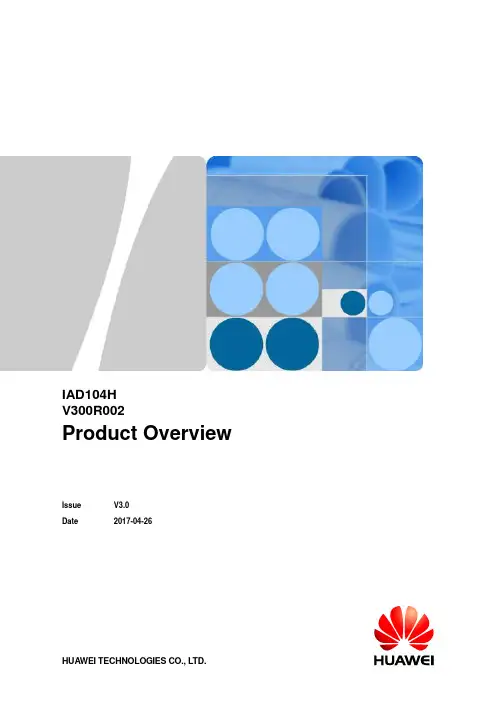
IAD104HV300R002Product OverviewIssue V3.0Date 2017-04-26Copyright © Huawei Technologies Co., Ltd. 2017. All rights reserved.No part of this document may be reproduced or transmitted in any form or by any means without prior written consent of Huawei Technologies Co., Ltd.Trademarks and Permissionsand other Huawei trademarks are trademarks of Huawei Technologies Co., Ltd.All other trademarks and trade names mentioned in this document are the property of their respective holders.NoticeThe purchased products, services and features are stipulated by the contract made between Huawei and the customer. All or part of the products, services and features described in this document may not be within the purchase scope or the usage scope. Unless otherwise specified in the contract, all statements, information, and recommendations in this document are provided "AS IS" without warranties, guarantees or representations of any kind, either express or implied.The information in this document is subject to change without notice. Every effort has been made in the preparation of this document to ensure accuracy of the contents, but all statements, information, and recommendations in this document do not constitute a warranty of any kind, express or implied.Huawei Technologies Co., Ltd.Address:Huawei Industrial Base Bantian, Longgang Shenzhen 518129 People's Republic of ChinaWebsite:Product Overview ContentsContents1 Product orientation and features (1)1.1 Product orientation (1)1.2 Product Features (2)2 Product structure (4)2.1 Overview (4)2.2 Hardware structure (4)2.2.1 Front panel (4)2.2.2 Rear panel (5)2.2.3 Software structure (6)3 Product and Networking Application (7)3.1 Overview (7)3.2 Networking Applications (8)3.2.1 Multiple Upstream Modes (9)3.2.2 Shop access (10)3.2.3 Home Access (11)4 Technical Specifications (12)4.1 Technical Specifications (12)4.2 Compliant Standards (13)A Glossary (15)1 Product orientation and features1.1 Product orientationThis product description is about IAD104H V300R001 version.The IAD (Integrated Access Device) 104H (the IAD104H for short) is an importantcomponent of Huawei next generation network (NGN/IMS) solution. It provides small-capacity voice over IP (V oIP) or fax over IP (FoIP) solutions for enterprises and consumerusers.With different access capabilities (IAD104H: four ports) for enterprises, the IAD104H is wellintegrated into enterprise broadband networks and achieves cost-efficient access for remoteenterprise users because of its comprehensive advantages (high quality, high benefits, and costefficiency). Its flexible networking and QoS policies ensure high quality of delay-sensitivevoice services and packet-loss-sensitive fax services for end users.Figure1-1 illustrates thenetworking of the IAD104H.Figure 1-1the location of IAD104H in the network1.2 Product FeaturesThe IAD104H features: high-quality voice, easy installation, convenient management andmaintenance, high reliability and security.High-Quality VoiceThe IAD104H provides high-efficiency and high-quality IP-based voice service, by thefollowing:●Voice Activity Detection (V AD)●Comfort Noise Generation (CNG)●Echo cancellation●Lost-packet compensationEasy InstallationThe IAD104H has a simple box structure and is installed on the desktop or in the corridor.It provides standard external ports and clear marks to facilitate the installation and cableconnection.It uses standard connectors and no special installation tools are needed.It supports auto-configuration through DHCP, which frees end users from manualconfiguration on IAD.ManageabilityThe 104H can be managed in many ways.●Local console manageIAD104H can be managed by local console port, that means computer connect with IADconsole port, using Windows 98, Windows NT, Windows 2000 or Windows XP superterminal software having by the operating system to manage.●TelnetYou can telnet to the system by network ports of the IAD104H for management. Easy MaintenanceThe IAD104H supports the following maintenance methods:●Through network ports for maintenance, you can rapidly and easily set the IAD104H anddetect its status.●Besides the Basic Input/ Output System (BIOS) mode, you can load host softwarethrough network ports by File Transfer Protocol (FTP).●The IAD104H enables device maintenance, fault detection and network managementalarms.High ReliabilityThe IAD104H ensures device reliability by the following:●Watch dog timer(WDT) helps automatic recovery in case of software abnormality.●Power supply and ports can be protected from over-current and over-voltage.High SecurityThe IAD104H realizes high security by the following:●UCEMS implements management on the IAD104H, and the SoftSwitch/IMS completesthe control functions. Before provisioning services, the IAD104H needs to register in theSoftSwitch/IMS for management and service authentication.●When an IAD104H device is put into service, the device ID, secret key, IP address ordomain name of the UCEMS, and IP address or domain name of the SoftSwitch, will beassigned onto the IAD104H. The information will not get lost even if the IAD104H ispowered off.●The IAD104H management system authorizes and authenticates users to preventunauthorized users from login to and operating the device. Users can be divided intocommon users, operators and managers. Authorities are subject to the user level. Even ifusers of different levels enter the same mode, they cannot run the same commands.●The IAD104H offers various logs, such as operation, alarm and debugging logs, torecord device operation and maintenance. Operation logs record user name, login time,login mode, IP address and operations. Alarm logs record major events during systemrunning. Most of such events are alarms. Debugging logs collect debugging information.2 Product structure2.1 OverviewIAD104H designed in box structure, the whole system is constitute of main control board,power board and box. This system doesn’t support online expand, the products we provide touser are fixed configuration.2.2 Hardware structureFigure 2-1the appearance of the IAD104H2.2.1 Front panelThe IAD104H provides indicators on its front panel. Table 1-1 lists names and meanings ofthe indicators.Table 2-1the indicators of IAD104H2.2.2 Rear panelFigure 2-2hows external ports on the IAD104H rear panel.Figure 2-2External ports of the IAD104HT able 2-2 lists functions and amount of the external ports.Table 2-2External ports of the IAD104H2.2.3 Software structureThe software structure of IAD104H is based on Vxworks, it is made of CSP board, CPU andDSP, as showing in Table 2-3.Table 2-3The software structure of IAD104HFrom the software structure, IAD104H can be separated in: management and maintenancemodule, service interface module, semi-permanent service processing module, V oIP serviceprocessing module, protocol processing module, operating system module (VxW orks) andbottom drive processing module. Figure 1-4 shows the relationship of every module.T able 1-5 shows the function of each module of IAD104H.Table 2-4Instruction of each module of IAD104HProduct Overview 3 Product and Networking Application3 Product and Networking Application3.1 OverviewIt provides V oIP access for up to four POTS users, and offers one LAN port and one WANport.Services and FunctionsThe IAD104H provides abundant voice and data services, functions as listed below:●Supporting POTS and enabling Ethernet users to access the IP network●Supporting 802.1p/q●Supporting T.38 fax or transparent transmission of faxes●Supporting Caller Identification Display●Supporting Advice of Charge at the End of Conversation (the IAD of MGCP only)●Enabling calling parties of the card service to redial numbers●Supporting Point-to-Point Protocol over Ethernet (PPPoE)●Supporting Network Address Translation(NA T)●Supporting traditional PSTN services●Supporting G.711 and G.729●Supporting KC charging and polarity reversal charging controlled by the SoftSwitch(IAD of MGCP only)●Supporting Differentiated Services Code point (DSCP)●Supporting Comfort Noise Generation (CNG)●Supporting V AD (Voice Activity Detection)●Cooperating with the SoftSwitch to provide new intellectual and distinctive services,such as Call Transfer Call Waiting , Calling Line Identification Presentation, Designatedpickup , Co-group pickup , Three-party call and Conference call (Note: the aboveservices can be used only after you subscribe them from the operator. For details, contactthe operator)●Supporting Simple Network Management Protocol (SNMP)●Supporting Simple Network Time Protocol (SNTP)●Supporting Dynamic Host Configuration Protocol (DHCP) and DHCP Relay●Supporting usage under execrable environments●Supporting end-to-end signaling tracing, and locating software/hardware faults insidedevices●Supporting IAD authentication by SoftSwitch●Supporting encryption of RFC2833 controlled by SoftSwitch (the IAD of SIP only)●Supporting certifications such as Federal Communications Commission (FCC), Councilof Europe (CE) and China Compulsion Certification (CCC)●Supporting auto-configuration through DHCP, which frees end users from manualconfiguration on IAD.3.2 Networking ApplicationsIAD104H can be applied in the below scene.3.2.1 Multiple Upstream ModesFigure 3-1Upstream modes of IAD104HTable 3-1Noun explain3.2.2 Shop accessFigure 3-2Shop access of IAD104HDescription:ONU realize Ethernet connect to equipment room of enterprise, IAD provide shopintegrate service access.Feature:One-line access, simple Deployment. Each shop access by one line, while providing voice,fax and broadband Internet access, meets the requirement of business office.Flexible service specification Networking. Providing 4 different configurationspecification to satisfy diversiform data, voice and fax application request.Supporting IP-Centrex. Support internal call by short number, improve work efficiency.Supproting Number Portability. It's not necessary to apply to change number and modifyIAD configuration when the relocation. Support plug and play, and fully protect the benefit ofthe merchants, such as telephone and fax number.3.2.3 Home AccessFigure 3-3Home access of IAD104HDescription:ONU is deployed in Residential districts, using the existing LAN SW to access to home.Features:One-line access, simple Deployment. ONU provide 8/16/24 port floor exchange, Eachretail access by one line with IAD, no need line repeatly. At the same time to increase thecustomer satisfaction and reduce deploying cost.PPPoE dial-up automatically. Through IAD’s embedded PPPoE function, PC connectedwith it can access Internet network directly without any other operation, thus simply theprocess of dial-up.Flexible Service CombinationT wo solutions can be provided according to different family requirements:a)Provide standard telephone and internet service;b)Fax service is added on the basis of solution A in SOHO environment.4 Technical Specifications 4.1 Technical SpecificationsTable 4-1IAD104H Technical Specifications4.2 Compliant StandardsThe IAD104H is in compliance with the following standards and protocols.Tone detection/generation●Dual tone multi-frequency (DTMF), call tones (such as dialing tone, busy tone, ring backtone, and offhook prompt tone)●V.17, V.21, V.27ter, V.29 standards●Automatic identification of voice and fax servicesVoice/Multimedia data signal codec●ITU-T G.711 μ-Law (64kbit/s)●ITU-T G.711 A-Law (64kbit/s)●ITU-T G.729Call signal protocol for call control●Internet Engineering Task Force (IETF) MGCP (RFC3435)●SIP (RFC3261)Encapsulation and decapsulation protocols of voice packets●RTP/Real-Time Control Protocol (RTCP) (RFC 1889)●Internet protocols●Transfer Control Protocol (TCP)/IP●User Datagram Protocol (UDP)/IP●Address Resolution Protocol (ARP)/Reverse Address●Resolution Protocol (RARP)●Internet Control Message Protocol (ICMP)●Telnet●Hypertext Transfer Protocol (HTTP) Web Server●Domain Name Server (DNS) Client●DHCP Client●FTP (File Transfer Protocol)/TFTP (Trivial File Transfer Protocol) ClientIP address allocation●Static●DHCP●PPPoEIP fax●Transparent transmission●Transmission mode meets ITU-T T. 38 Real-Time IP G3 fax protocol, with the rate lessthan 14400 bit/sA Glossary Table 4-2Abbreviations。

华为softco语音交换机基本业务话机操作指南华为技术有限公司Huawei Technologies Co., Ltd.版权所有侵权必究All rights reserved目录本机号码查询业务 (3)如何使用 (3)呼叫前转业务 (3)无条件呼叫前转业务 (4)如何使用 (4)无应答呼叫前转业务 (5)如何使用 (5)遇忙呼叫前转业务 (6)如何使用 (6)转移呼叫业务 (7)如何使用 (7)呼叫保持业务 (8)如何使用 (8)代答业务 (8)同组代答业务 (8)指定代答业务 (9)呼叫预留业务 (9)如何使用 (9)呼叫等待业务 (10)如何使用 (10)三方通话业务 (11)如何使用 (11)闹钟业务 (12)如何使用 (12)本机号码查询业务如何使用在话机上通过拨号查询本机号码。
登记业务无。
使用业务本业务允许用户拨打一个特殊字冠查询本机号码或本机的一号通号码,业务使用方法如下:∙用户A 摘机→拨打“*128#”,系统向A播报本机的号码。
∙用户A 摘机→拨打“*125#”,系统向A播报本机的一号通号码。
说明:∙A是局内用户。
∙由于本机号码查询业务需要语音资源,当语音资源全部被占用时,局内用户拨打时将会听到忙音。
撤消业务无。
呼叫前转业务∙概述呼叫前传业务可以将所有主叫用户的呼叫前传到预先设定的号码,而不管被叫用户处于何种状态。
∙无条件呼叫前转业务所有对用户的呼叫将被前转到预先设定的号码,而不管该用户处于何种状态。
∙无应答呼叫前转业务对用户的呼叫在20秒内无应答时均自动前转到预先设定的号码。
∙遇忙呼叫前转业务在用户忙时,对该用户的呼叫将自动前转到预先设定的号码。
无条件呼叫前转业务如何使用介绍如何登记、使用和撤消所有的呼叫被前转到预先设定的号码,而不管该用户处于何种状态。
登记业务用户A摘机→拨“*57*TN#”,可以听到成功登记业务的提示音。
说明:∙A是具有无条件呼叫前转业务权限的用户。
∙TN为前转用户B的号码。
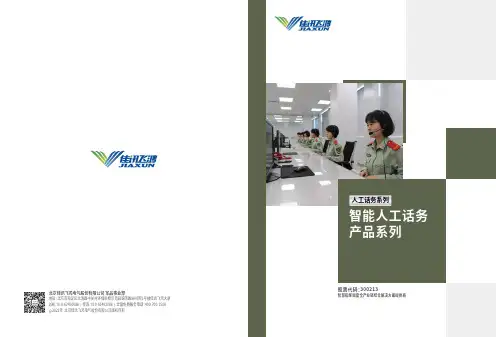
The Supplier Of Integrated Solutions Of The Whole IntelligentCommand And Dispatch Industry Chain智慧指挥调度全产业链综合解决方案提供商股票代码:300213智能人工话务产品系列人工话务系列北京佳讯飞鸿电气股份有限公司 军品事业部地址:北京市海淀区北清路中关村环保科技示范园锦带路88号院1号楼佳讯飞鸿大厦总机:************|传真:************|全国免费服务电话:400-700-1508北京佳讯飞鸿电气股份有限公司 军品事业部地址:北京市海淀区北清路中关村环保科技示范园锦带路88号院1号楼佳讯飞鸿大厦总机:************|传真:************|全国免费服务电话:400-700-1508智能人工话务产品系列INTELLIGENT HUMAN CALL PRODUCT SERIES话务一体化综合解决方案智慧指挥调度全产业链综合解决方案提供商股票代码:300213话务值勤业务运维管理业务考核训练业务INTELLIGENT HUMAN CALL PRODUCT SERIES智能人工话务产品系列智慧指挥调度全产业链综合解决方案提供商股票代码:300213北京佳讯飞鸿电气股份有限公司 军品事业部地址:北京市海淀区北清路中关村环保科技示范园锦带路88号院1号楼佳讯飞鸿大厦总机:************|传真:************|全国免费服务电话:400-700-1508INTEGRATED TRAFFIC MANAGEMENT SOLUTION话务值勤业务运维管理业务考核训练业务话务一体化综合解决方案公司资质科技创新公司概况北京佳讯飞鸿电气股份有限公司创立于1995年初,2011年登陆A股(股票代码:300213),经过多年稳步发展,现已成为智慧指挥调度全产业链综合解决方案提供商,目前旗下拥有28家参控股公司,为中国及全球十余个国家的用户提供创新、高效、可靠的新一代信息基础设施技术应用及服务。


1的SmartCall产品说明书目录1. 产品概述................................................................................................. 错误!未定义书签。
2. 主要功能................................................................................................. 错误!未定义书签。
2.1. 智能电话交换(PBX)............................................................... 错误!未定义书签。
2.2. IVR(自动语音应答) ............................................................... 错误!未定义书签。
2.3. ACD(自动话务分配).............................................................. 错误!未定义书签。
2.4. 软电话功能................................................................................. 错误!未定义书签。
2.5. 通话录音(Call Record) .............................................................. 错误!未定义书签。
2.6. 话务统计分析(Reporting & Analytics) ....................................... 错误!未定义书签。
2.7. 电子传真..................................................................................... 错误!未定义书签。
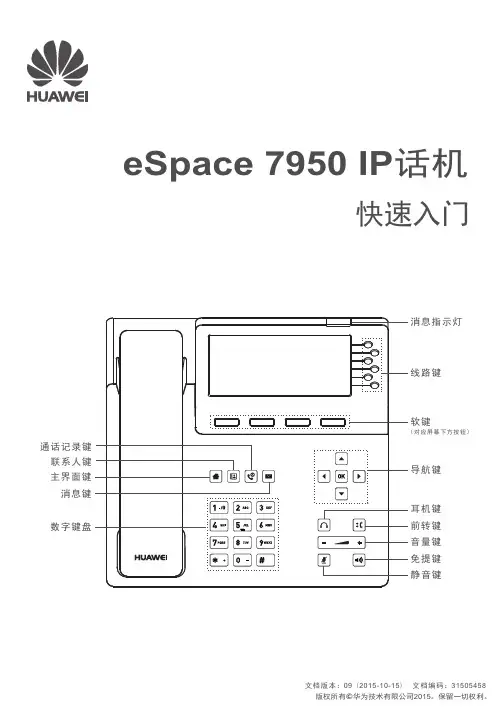
快速入门eSpace 7950 IP 话机版权所有©华为技术有限公司2015。
保留一切权利。
主界面键消息键数字键盘文档版本:09(2015-10-15) 文档编码:31505458Quick Start GuideeSpace 7950 IP PhoneCopyright © Huawei Technologies Co., Ltd. 2015. All rights reserved.Line buttonsSoftkey buttonsNavigation buttonsMute button Speaker button Volume button Headset buttonContactsb Call HistoryMWIbuttonForward button Issue: 09 (2015-10-15) Part Number: 31505458装箱清单12线路,5英寸真彩大屏,轻薄时尚支持USB 可扩展接口,支持外接扩展模块2个千兆以太网接口,支持以太网供电AAC-LD 全带语音编码,支持蓝牙耳机7950 打开产品包装后,请对照以下列表检查各组件是否齐备。
若有遗漏,请与经销商联系。
主机 x 1手柄x 1快速入门 x 1手柄线 x 1直通网线 x 1您可以按照以下步骤登录话机主界面:2. 。
输入号码(Number )、密码(Password ),按<登录(Log In )>软键进入话机主界面1.话机上电后,进入登录界面。
登录扩展板接口,连接外接扩展板1PC 接口,连接计算机的网络接口3网络接口,连接局域网或公网4耳麦接口,连接外接耳麦53452电源接口,连接外部电源手柄连线接口,连接话机手柄6话机背面PC (可选)网络RJ-9耳机电源注意USB接口(屏幕后方),连接USB设备扩展板(可选)登录时,请确认话机已经正常连接网络,即登录界面右上角未出现 图标。

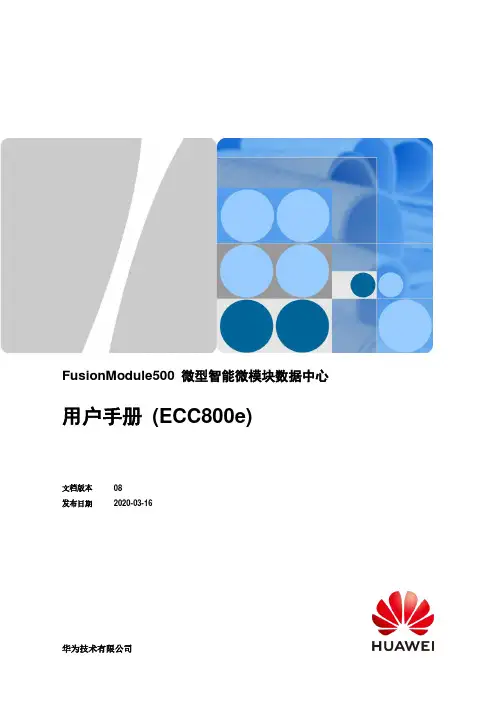
FusionModule500 微型智能微模块数据中心用户手册(ECC800e)文档版本08发布日期2020-03-16版权所有© 华为技术有限公司2020。
保留一切权利。
非经本公司书面许可,任何单位和个人不得擅自摘抄、复制本文档内容的部分或全部,并不得以任何形式传播。
商标声明和其他华为商标均为华为技术有限公司的商标。
本文档提及的其他所有商标或注册商标,由各自的所有人拥有。
注意您购买的产品、服务或特性等应受华为公司商业合同和条款的约束,本文档中描述的全部或部分产品、服务或特性可能不在您的购买或使用范围之内。
除非合同另有约定,华为公司对本文档内容不做任何明示或默示的声明或保证。
由于产品版本升级或其他原因,本文档内容会不定期进行更新。
除非另有约定,本文档仅作为使用指导,本文档中的所有陈述、信息和建议不构成任何明示或暗示的担保。
华为技术有限公司地址:深圳市龙岗区坂田华为总部办公楼邮编:518129网址:https://前言概述●本文档介绍了FusionModule500微型智能微模块数据中心(本文简称为智能微模块)产品的安装、调测、运行和维护过程。
●本手册中的界面对应软件版本号V100R002C00。
读者对象本文档主要适用于以下人员:●行销工程师●技术支持工程师●系统工程师●硬件安装工程师●调测工程师●数据配置工程师●维护工程师符号约定在本文中可能出现下列标志,它们所代表的含义如下。
修订记录修改记录累积了每次文档更新的说明。
最新版本的文档包含以前所有文档版本的更新内容。
文档版本08 (2020-03-16)优化“准备和登录Web”章节。
文档版本07 (2019-12-20)更新安全注意事项。
文档版本06 (2019-11-22)刷新密码修改说明。
文档版本05 (2019-03-10)刷新手册名称等。
文档版本04 (2019-03-06)刷新摄像机和VCN调测内容。
文档版本03 (2018-10-31)新增VCN540安装方案。

TopEng-智能呼叫中心安装指南目录目录36 网络呼叫中心的实现原理 ...................................................................................................... 36-136.1 系统概述.................................................................................................................................................................... 36-236.2 组网方式.................................................................................................................................................................... 36-236.3 共享设备呼叫分配策略......................................................................................................................................... 36-436.3.1 分配策略简介 ................................................................................................................................................ 36-436.3.2 按照综合费用分配 ....................................................................................................................................... 36-536.3.3 按照比例分配 ................................................................................................................................................ 36-636.3.4 按照路由表达式分配................................................................................................................................... 36-836.3.5 按照费用阈值分配 ....................................................................................................................................... 36-936.3.6 按照呼叫中心分配 .....................................................................................................................................36-1136.4 共享座席呼叫分配原则.......................................................................................................................................36-1136.4.1 内部呼叫 .......................................................................................................................................................36-1236.4.2 内部求助 .......................................................................................................................................................36-1236.4.3 呼叫转移 .......................................................................................................................................................36-1336.5 网络虚拟呼叫中心建立原则..............................................................................................................................36-1436.6 CCS类型客户端设置原则...................................................................................................................................36-1436.7 网络呼叫客户级别提取方法..............................................................................................................................36-1636.8 设备占用率计算方法 ...........................................................................................................................................36-1636.9 术语说明..................................................................................................................................................................36-1737 安装及配置网络呼叫中心 ...................................................................................................... 37-137.1 安装前须知............................................................................................................................................................... 37-237.1.1 NIRC和NRMS安装须知 ........................................................................................................................... 37-237.1.2 文件服务器设置须知................................................................................................................................... 37-237.1.3 工号配置须知 ................................................................................................................................................ 37-337.1.4 配置网络呼叫中心参数须知...................................................................................................................... 37-337.2 安装网络呼叫中心组件......................................................................................................................................... 37-337.2.1 NIRC安装在UNIX系统下 ........................................................................................................................ 37-337.2.2 NIRC和NRMS都安装在Windows系统 ............................................................................................... 37-437.3 登录NRMS............................................................................................................................................................... 37-637.4 配置NIRC客户端 .................................................................................................................................................. 37-7目录TopEng-智能呼叫中心安装指南37.4.1 将单点呼叫中心设置为NIRC客户端 .................................................................................................... 37-7 37.4.2 将NRMS作为NIRC客户端..................................................................................................................... 37-937.5 配置网络虚拟呼叫中心.......................................................................................................................................37-1137.6 配置共享座席.........................................................................................................................................................37-1237.7 配置NIRC参数.....................................................................................................................................................37-1438 网络呼叫中心配置实例 .......................................................................................................... 38-138.1 背景介绍.................................................................................................................................................................... 38-238.1.1 配置前说明..................................................................................................................................................... 38-238.1.2 前提条件 ......................................................................................................................................................... 38-238.2 在UA P设置............................................................................................................................................................. 38-338.2.1 为呼叫中心CC1配置UAP数据 ............................................................................................................. 38-338.2.2 为呼叫中心CC2配置UAP数据 ............................................................................................................. 38-438.3 在NRMS进行基本配置 ....................................................................................................................................... 38-538.3.1 增加客户端..................................................................................................................................................... 38-538.3.2 增加网络虚拟呼叫中心NETVCC1 ......................................................................................................... 38-638.3.3 增加共享座席 ................................................................................................................................................ 38-638.4 在Web配置台进行NIRC配置........................................................................................................................... 38-738.4.1 设置按比例路由共享设备.......................................................................................................................... 38-838.4.2 设置路由表达式共享设备.......................................................................................................................... 38-938.4.3 设置路由费用 ................................................................................................................................................ 38-938.5 在Web配置台进行呼叫中心设置....................................................................................................................38-1038.5.1 打开网络呼叫中心开关.............................................................................................................................38-1038.5.2 映射系统用户 ..............................................................................................................................................38-1238.5.3 映射虚拟呼叫中心业务代表....................................................................................................................38-1338.5.4 在呼叫中心CC1设置设备.......................................................................................................................38-1338.5.5 在呼叫中心CC2(CC3)设置设备.......................................................................................................38-1538.6 在报表系统进行更改 ...........................................................................................................................................38-1638.6.1 呼叫中心CC1报表数据更改..................................................................................................................38-1638.6.2 同步网络呼叫中心话单到平台数据库..................................................................................................38-1638.7 验证结果..................................................................................................................................................................38-17TopEng-智能呼叫中心安装指南插图目录插图目录图36-1 将NIRC配置在某一个呼叫中心的组网示例 ........................................................................................... 36-3图36-2 设置共享设备路由策略举例.......................................................................................................................... 36-5图36-3 在虚技能队列设置路由策略举例................................................................................................................. 36-5图36-4 按照费用阈值路由..........................................................................................................................................36-10图36-5 按呼叫中心转移举例 .....................................................................................................................................36-11图36-6 设置客户端举例 ..............................................................................................................................................36-15图36-7 在Web配置台设置子呼叫中心编号和客户端ID对应关系举例......................................................36-15图37-1 选择NIRC和NRMS ....................................................................................................................................... 37-4图37-2 NIRC配置精灵................................................................................................................................................... 37-5图37-3 NRMS登录窗口................................................................................................................................................. 37-6图37-4 NIRC客户端配置窗口...................................................................................................................................... 37-7图37-5 将NRMS作为NIRC客户端......................................................................................................................... 37-9图38-1 增加呼叫中心客户端 ....................................................................................................................................... 38-6图38-2 设置网络虚拟呼叫中心................................................................................................................................... 38-6图38-3 增加共享座席..................................................................................................................................................... 38-7图38-4 设置共享设备..................................................................................................................................................... 38-8图38-5 设置按比例路由共享设备 .............................................................................................................................. 38-8图38-6 设置按路由表达式路由共享设备................................................................................................................. 38-9图38-7 设置路由费用...................................................................................................................................................38-10图38-8 打开CC1网络呼叫中心开关.......................................................................................................................38-11图38-9 打开CC2网络呼叫中心开关.......................................................................................................................38-11图38-10 打开CC3网络呼叫中心开关 ....................................................................................................................38-12图38-11 映射系统用户.................................................................................................................................................38-12图38-12 映射系统用户后的效果...............................................................................................................................38-12图38-13 映射虚拟呼叫中心业务代表......................................................................................................................38-13插图目录TopEng-智能呼叫中心安装指南图38-14 设置虚队列.....................................................................................................................................................38-14图38-15 设置共享设备 ................................................................................................................................................38-14图38-16 CC2设置共享设备 ........................................................................................................................................38-15图38-17 DataStation数据同步界面............................................................................................................................38-16TopEng-智能呼叫中心安装指南表格目录表格目录表36-1 共享设备呼叫分配策略................................................................................................................................... 36-4表36-2 设置路由费用举例............................................................................................................................................ 36-6表36-3 按比例分配路由原则 ....................................................................................................................................... 36-6表36-4 按比例分配路由举例 ....................................................................................................................................... 36-7表36-5 路由费用设置举例..........................................................................................................................................36-10表37-1 登录参数说明..................................................................................................................................................... 37-6表37-2 客户端参数说明 ................................................................................................................................................ 37-8表37-3 NRMS作为NIRC客户端参数说明.............................................................................................................. 37-9表37-4 增加虚拟呼叫中心..........................................................................................................................................37-11表37-5 共享座席参数说明..........................................................................................................................................37-12表37-6 NIRC参数..........................................................................................................................................................37-14表38-1 被叫号码分析表 ................................................................................................................................................ 38-3表38-2 被叫号码分析表 ................................................................................................................................................ 38-4表38-3 配置号首处理表 ................................................................................................................................................ 38-4表38-4 配置号码变换表 ................................................................................................................................................ 38-4表38-5 配置被叫分析号码............................................................................................................................................ 38-4表38-6 配置业务属性表 ................................................................................................................................................ 38-5TopEng-智能呼叫中心安装指南36 网络呼叫中心的实现原理36 网络呼叫中心的实现原理关于本章本章描述内容如下表所示。
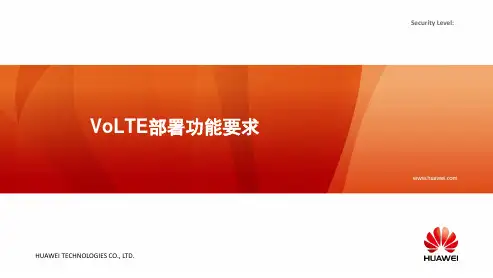
HUAWEI智能呼叫中心话单指南智能呼叫中心(Intelligent Call Center)作为华为电信解决方案中的一部分,提供了强大的呼叫管理和服务质量控制功能。
为了帮助用户更好地理解和使用智能呼叫中心,华为特意编写了《智能呼叫中心话单指南》(版本号V300R005C15_01),以下是该指南的详细介绍。
一、指南概述《智能呼叫中心话单指南》是一份详细的使用手册,旨在帮助用户了解智能呼叫中心的话单信息和相关的操作流程。
该指南包含的内容主要有话单的定义、格式、重要字段的解释等。
二、指南内容1.话单定义和作用该部分详细介绍了话单的概念,并解释了话单在智能呼叫中心中的作用和重要性。
话单是记录呼叫中心中呼叫信息的记录,通过分析话单可以获得呼叫中心的运营情况和性能数据。
2.话单格式该部分介绍了智能呼叫中心话单的格式和组成部分。
智能呼叫中心话单的格式采用了标准的行分隔符和字段分隔符,每个字段包含各种呼叫信息。
3.重要字段解释该部分详细解释了话单中的一些重要字段,包括呼叫开始时间、结束时间、主叫号码、被叫号码、呼叫类型、通话时长等。
用户可以通过这些字段了解呼叫的基本信息和呼叫质量。
4.话单统计和分析该部分介绍了如何使用智能呼叫中心话单进行统计和分析。
用户可以通过分析话单数据,了解呼叫中心的负载情况、呼叫质量、呼叫趋势等。
5.话单导出和导入该部分介绍了如何将话单数据导出为Excel文件或其他格式,以便用户进行更加灵活的数据处理和分析。
同时也介绍了如何将已经处理好的话单数据导入到智能呼叫中心中进行进一步分析和管理。
三、指南使用说明该指南给出了一些使用注意事项和常见问题解答,以帮助用户更好地理解和使用智能呼叫中心话单指南。
用户在使用指南过程中如有疑问可以参考该部分进行解决。
总结:《智能呼叫中心话单指南》(版本号V300R005C15_01)是一份详细的使用手册,主要介绍了智能呼叫中心话单的定义、格式、重要字段的解释以及话单的统计、分析、导出和导入等操作流程。
华为接⼊⽹产品单板⼿册华为接⼊⽹产品产品⼿册1 概述在实际的维护中,如果现场⼯区⼯程师对各种单板的指⽰灯含义⽐较清楚,对定位故障是⼤有帮助的。
了解指⽰灯正常运⾏状态,可以直观判断单板的运⾏情况;了解单板在复位或加载过程中指⽰灯的变化情况,则能有效帮助我们定位故障点。
因此本⽂详细介绍了接⼊⽹主要单板的指⽰灯含义,希望能对⼴⼤客户的维护有所帮助。
2 单板指⽰灯详细说明2.1 AV5板指⽰灯详细说明03030561 HV01A V50-V5.2协议处理及主控板⽤于GV5-I主控框(2M板为DTM),⽀持2E1接⼝,与H30系列A V5不通⽤!03031229 H302A V50-协议处理及主控03036341 H303A V50-协议处理及主控⽤于GV5-III主控框(2M板为DTE)1、HV01A V5单板正常运⾏时的灯态:RUN:运⾏灯,指⽰运⾏状态、主备板状态、360程序加载等;1000ms亮,1000ms灭:主⽤正常1900ms亮,100ms灭:正在由备⽤升主⽤进⾏平滑处理100ms亮,1900ms灭:备⽤正常250ms亮,250ms灭:正在加载或主备⾝份还未确定<250ms亮,<250ms灭:加载程序的最后阶段,正在解压缩V5S:V5接⼝状态指⽰灯;亮:V5接⼝正常灭:V5接⼝异常V5L :V5链路状态指⽰灯;常亮:所有V5链路层正常常灭:所有V5链路层异常1s亮,1s灭:有⼀条链路不正常,如果这时候V5S亮,则说明有链路坏掉其他情况:若⼲条链路异常,闪的频率越⾼,坏的越多,但⼀般来说,只有上述三种状态。
MSL:主备板通信链路状态指⽰灯;亮:链路正常灭:链路异常COM:与后台通信状态指⽰等;亮:链路正常灭:链路异常CLK :当前时钟主⽤指⽰灯;亮:当前该板提供时钟,既该板时钟主⽤灭:当前该板不提供时钟,既该板时钟备⽤E11 :E11物理状态指⽰灯;亮:E11正常灭:E11异常E12 :E12物理状态指⽰灯;亮:E12正常灭:E12异常NOD :188NOD指⽰灯。
话务台安装维护使用手册目录华为CC08话务台1.话务台安装1.1 硬件安装1.2 软件安装1.2.1 话务台终端软件安装1.2.2 安装CTX卡驱动程序1.3 话务台设置1.3.1 用户登录设置1.3.2 用户授权设置1.3.3 设置计费数据1.4 安装注意项2.话务台扩展功能2.1 电脑话务员2.2 夜间服务2.3 浏览呼叫记录2.4 话单传送2.5 号码姓名对照表2.6 维护长短号3.常见故障处理话务台安装维护使用手册08话务台常见故障处理流程中兴ZXJ10-B综合话务台一.综合话务台安装1.话务台简介2.话务台软件安装3.话务台硬件安装4.话务台运行设置二.中兴综合话务台故障处理华为篇1.话务台安装1.1 硬件安装CTX卡是Centrex话务台接口板,它插在PC机的PCI,通过双绞线与DSL板相连,通过插孔与耳机(包括话筒)相连,实现Centrex话务台的各项功能。
CTX卡有C802CTX、C803CTX两种,现在都是用的C803CTX。
(1). C803CTXC803CTX卡插在话务台(PC机)的PCI总线扩展槽中。
C803CTX单板没有跳线,也没有拨码开关。
C803CTX卡有三个接口:EARPHONE、RECEIVE、LINE,C803CTX卡接口如图2所示。
EARPHONE是四芯普通电话插座,为话务台耳机接口。
RECEIVE是四芯普通电话插座,为手柄接口。
LINE是六芯普通电话插座,为外线接口,中间两芯接双绞线与交换机侧的DSL板相连。
图21C803CTX卡接口示意图该板有一个线路状态指示灯,位于EARPHONE插孔上面。
慢闪(1秒亮1秒灭)表示单板运行正常,但是U口没有激活;快闪(1/4秒亮1/4秒灭)表示单板运行正常,并且U口已经激活。
C803CTX卡支持电脑话务员功能,电脑话务员的提示语音存在一片Flash内,可以通过话务台的耳机话筒反复录音,语音的长度最长可以达到60秒。
需要注意的是,电脑话务员功能只支持DTMF信号的识别,如果对方是脉冲拨号,CTX卡则不识别,这种情况可以通过终端软件设置,给用户回忙音或者把该电话转到值班分机。